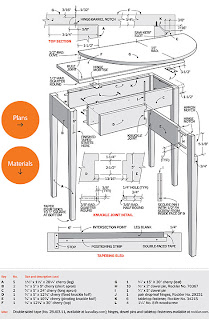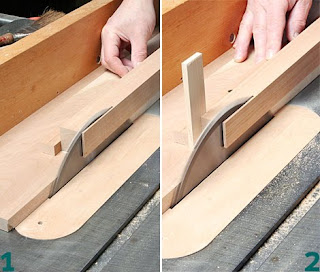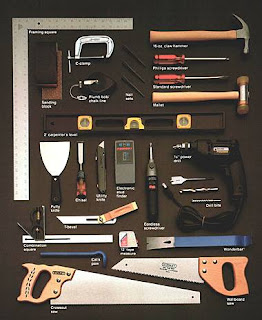Finding just a bit more table space in a hallway or living room, only when you need it, isn't easy. A classic solution is the drop-leaf table, a 16th-century design still useful today because it's so efficient. Lift the leaf when you want more surface area. Drop it when you want a slimmer, neater look. There are several variations on these tables--and we chose the simplest one, with a single leaf and a fifth leg that swings out to support it. It's perfect for a foyer and can be built with basic tools and a small table saw in a home workshop.
Probably the trickiest step is cutting the leg tapers. We made it easier by designing a sled that carries the leg safely past a table saw blade at any angle. Additionally, the legs and aprons of the base go together with simple dowel joints and the top attaches easily, with screw-on fasteners. The result is a sophisticated design that you don't need sophisticated skills to carry out.
Make the Legs and Aprons
Rip and crosscut the leg blanks and the aprons. Then cut a groove for the tabletop fasteners in each of the four leg aprons. Make the sled base, stop block and positioning strip. Lightly clamp a leg blank to the sled base, and adjust the leg so it overhangs the sled edge by 14 in. Pivot the leg so the overhang intersects the edge at 6 to 7 in. from the leg's top. Firmly clamp the leg to the sled and attach the stop and positioning strip. Stick a strip of double-sided tape to the sled base. Set the saw fence for the width of the sled, place the leg on the sled and guide it past the blade [ 1 ]. Rotate the blank clockwise and rip the adjacent side. To rip the two remaining sides, place a 14-in.-thick spacer between the positioning strip and the blank [ 2 ]. Use a plane or sander to remove saw marks.
Join the Aprons and Legs
Use a dowel jig to bore holes in the aprons [ 3 ]. Wind a piece of masking tape around the bit to act as a depth stop. Spread some glue on the dowels and in the dowel holes, then clamp together two subassemblies--two legs and a short apron. After the glue has cured on those, join the subassemblies to the long aprons [ 4 ]. Shape the knuckle on the fixed gateleg apron, and use the dowel jig to bore the hole through the knuckle. Unless you have an unusually long bit, you'll need to use the dowel jig and bore the hole from both edges toward the center. Now cut the knuckle on the pivoting gateleg apron, test fit it to the fixed knuckle, then use the pivot hole in the fixed side to guide the drill bit through the pivoting side. Fasten the fixed apron to the table base; attach the pivoting apron with a dowel.
Make the Top
Rip and crosscut boards for the top and drop leaf. Plane the edge of each board smooth and straight; then glue and clamp two separate panels. Cut the top to finished size. Next, use a router and matched-pair router bits to cut the rule-joint edge on the top and the drop-leaf panel. Position each hinge on the top, and use a knife to mark its perimeter. Cut a shallow sloping notch around the perimeter, then finish the hinge mortise by paring as shown [ 5 ]. Screw the hinges to the top and position the drop leaf adjacent to it. Mark the corresponding hinge positions and cut the hinge mortises. Join the top and drop leaf; then use a large trammel to mark the curved edge. Separate the top and the leaf and cut the curve using a jigsaw [ 6 ]. Carefully plane and sand the leaf's circumference to shape.
Fasten the Top
Position the base on the inverted top and mark the location of the hinge knuckle on the gateleg and pivoting apron [ 7 ]. Cut a notch in these parts so they clear the hinge knuckle when they swing shut. After the notch is cut, position the top so it overhangs the base equally. Insert the tabletop fasteners in the apron grooves, and mark the hole locations in the top [ 8 ]. Remove the base, and bore pilot holes on each mark. Finish sand the top and apply finish to both sides of the top. Finishing both sides ensures equal moisture absorption and helps the top stay flat. Apply finish to the legs and the front and back surfaces of the aprons. Place the top on a padded surface, invert the base on it, and attach the base to the top by driving screws through each tabletop fastener and into the pilot hole.
You can get over 14,000.00 woodworking plans for sheds, decks, dressers, bookcases and many other woodworking projects.
Click Here Now!
http://www.woodworkingdiy.info/
Friday, July 16, 2010
Wednesday, May 5, 2010
DIY Tips For Installing A Floor
Here is a example of basic floor installation. Just to give you idea of what the steps are for removing an old floor and replacing it with a new one.
1. Once you have selected a new flooring to install, evaluate your existing floor to determine whether you can install the new flooring over it.
2. If necessary, remove the existing flooring to provide a sound surface for your new floor installation.
3. Install the appropriate type of underlayment for your floor covering.
4. Lay out your installation. For resilient or ceramic tile, establish layout lines that divide the room into quadrants. For sheet vinyl, create a template of the room perimeter. For carpet, determine the positions of seams.
5. Install your floor covering using the appropriate techniques: resilient flooring, ceramic tile, hardwood flooring, and carpet
Find out how to do all sorts of diy projects with step -by-step instructions and videos.
1. Once you have selected a new flooring to install, evaluate your existing floor to determine whether you can install the new flooring over it.
2. If necessary, remove the existing flooring to provide a sound surface for your new floor installation.
3. Install the appropriate type of underlayment for your floor covering.
4. Lay out your installation. For resilient or ceramic tile, establish layout lines that divide the room into quadrants. For sheet vinyl, create a template of the room perimeter. For carpet, determine the positions of seams.
5. Install your floor covering using the appropriate techniques: resilient flooring, ceramic tile, hardwood flooring, and carpet
Sunday, May 2, 2010
Tools For Woodworking
I wanted to make a list of tools that can help you with most projects. These are suggestions and not every tool has to be purchased immediately. Take your time and find out what tools you may use more then others.
A good starter tool set you will want to have a selection of hand tools and a decent power drill. With these items, you will be able to start and complete many diy woodworking projects.
I recommend that you inspect the finish of your hand tools. It pays in the end to purchase quality tools if possible. Do not go into debt, buying the most expensive tools. Just a few quality tools will be fine.
Usually a quality hand toll is made of high-carbon steel and is machined with clean-cut metal surfaces. It is always wise to make sure the handle of the tools are tight and not flimsy, also they should feel comfortable in your hand.
Start your collection of tools with a as need attitude. As you become more comfortable with woodworking and would like to tackle a more complicated project then invest in what tools you may need.
The benefit of investing in quality tools made by reputable manufactures, they always carry a full parts and labor warranty. This can be a huge savings. Cheaper tools will usually break and have to be replaced.
When you buy any power tools the horsepower, cutting capacity and motor speed is what you are looking for. Do not buy the most powerful or biggest power tool it is not necessary.
Nevertheless, like hand tools quality matters. Check for roller or ball bearings instead of sleeve bearings. You want a good heavy-duty trigger switch and reinforced power cord.
Here is a list of basic tools that you will able to start any woodworking project with
Framing square plumb bob/chalk line
Combination square nail sets
Wallboard saw electric stud finder
Crosscut saw utility knife
16 oz claw hammer putty knife
Phillips screwdriver cats paw
Standard screwdriver wonder bar
Sanding block chisel
2 foot carpenters level T-level
C-clamp 12-foot tape measure
¾ horsepower drill with bits mallet
Cordless screwdriver
Finally when looking for a tool box the ones made of plastic or metal are good investments. They are lightweight and durable. Also tool boxes that come with cantilevered trays and divided compartments will keep your tools and materials organized much better.
With proper care a quality tool will last a lifetime. I still use tools that belonged to my father and grandfather.
Read more http://www.woodworkingdiy.info/
A good starter tool set you will want to have a selection of hand tools and a decent power drill. With these items, you will be able to start and complete many diy woodworking projects.
I recommend that you inspect the finish of your hand tools. It pays in the end to purchase quality tools if possible. Do not go into debt, buying the most expensive tools. Just a few quality tools will be fine.
Usually a quality hand toll is made of high-carbon steel and is machined with clean-cut metal surfaces. It is always wise to make sure the handle of the tools are tight and not flimsy, also they should feel comfortable in your hand.
Start your collection of tools with a as need attitude. As you become more comfortable with woodworking and would like to tackle a more complicated project then invest in what tools you may need.
The benefit of investing in quality tools made by reputable manufactures, they always carry a full parts and labor warranty. This can be a huge savings. Cheaper tools will usually break and have to be replaced.
When you buy any power tools the horsepower, cutting capacity and motor speed is what you are looking for. Do not buy the most powerful or biggest power tool it is not necessary.
Nevertheless, like hand tools quality matters. Check for roller or ball bearings instead of sleeve bearings. You want a good heavy-duty trigger switch and reinforced power cord.
Here is a list of basic tools that you will able to start any woodworking project with
Framing square plumb bob/chalk line
Combination square nail sets
Wallboard saw electric stud finder
Crosscut saw utility knife
16 oz claw hammer putty knife
Phillips screwdriver cats paw
Standard screwdriver wonder bar
Sanding block chisel
2 foot carpenters level T-level
C-clamp 12-foot tape measure
¾ horsepower drill with bits mallet
Cordless screwdriver
Finally when looking for a tool box the ones made of plastic or metal are good investments. They are lightweight and durable. Also tool boxes that come with cantilevered trays and divided compartments will keep your tools and materials organized much better.
With proper care a quality tool will last a lifetime. I still use tools that belonged to my father and grandfather.
Read more http://www.woodworkingdiy.info/
Tuesday, April 27, 2010
Make and Install Floating Shelves
The other day I was looking something up on Google and was amazed when I googled the word shelves.
The overwhelming interest in floating shelves was unbelievable. Then of course, I remember you can now buy them in stores like Target and Lowes and many other home decorating stores. I think even Bed Bath and Beyond carries floating shelves.
I always thought they were attractive especially in kitchens and bathrooms where you may not have a lot of storage space.
The floating shelf has been around form many years. They first came on the scene in the 1950’s. They were considered very new age and contemporary for their time.
Like many trends, they are making a big comeback. I am happy about that. Especially for the do-it-yourself woodworker.
Installing a floating shelf is a very easy project using only the most basic of tools.
Here are two easy installations. You can build your own wall shelf. It is nothing more then a small hollow box. You can use plywood or pine.
The box’s top and bottom panels rest in rabbets cut into the sides and front, which are mitered at the front corners. The wall cleat is a piece of 2 x 4 sawed to width.
Your first option is to bore a pair of holes into wall studs, insert metal bars or wood dowels into the framing and slip a solid wood shelf over the supports.
The important part of this installation is to make sure the holes in the framing and the shelf are bored so they are parallel to one another and in the same plane. Otherwise the shelf will not easily slip over the supports.
Your second option is a better because it can be more forgiving of small inaccuracies in construction and installation.
Build the shelf, which is nothing more than a small hollow box, and test fit the wall cleat in it. Then simply attach the wall cleat to the studs, slip the shelf over it and screw the shelf to the cleat. Although it is ideal to mount the cleat to two studs, you can also attach it to a stud on one end and use a hollow wall anchor at the other end.
Now I remember why these shelves are so popular they are easy to make and fit into any room of your house.
For more DIY woodworking plans and projects go to http://www.woodworkingdiy.info/
Saturday, April 24, 2010
Easy Woodworking Plans
I love building things for my home and family. With a few basic tools and some great plans, you can build just about anything.
I have made bookcases, and tables even grandfather clocks. Outside I have put up many bird houses, and a couple nice sheds.
Also I have added moulding to rooms in the house. Crown moulding in the livingroom. Also I love large baseboard molding it adds character to any room.
Do you know you can make great swing sets for your kids and grandkids. When you get the plans and make them yourself, you know they are strong and safe.
Naturally many of us have made decks. You can literally save yourself thousands of dollars by building your own deck. Trust me out a many of the projects listed making a deck is be far the easiest. Again I cannot express enough how much money you will save by building your own deck.
I would like to turn our spare bedroom into a very classy library. With beautiful built in bookcases, and a no cleareance gas fire place.
This is my first blog. I hope you will follow along with me as I start my woodworking projects.
I hope we can all learn some tips and make some great things for our homes.
For project plans and more info go to http://www.woodworkingdiy.info/
I have made bookcases, and tables even grandfather clocks. Outside I have put up many bird houses, and a couple nice sheds.
Also I have added moulding to rooms in the house. Crown moulding in the livingroom. Also I love large baseboard molding it adds character to any room.
Do you know you can make great swing sets for your kids and grandkids. When you get the plans and make them yourself, you know they are strong and safe.
Naturally many of us have made decks. You can literally save yourself thousands of dollars by building your own deck. Trust me out a many of the projects listed making a deck is be far the easiest. Again I cannot express enough how much money you will save by building your own deck.
I would like to turn our spare bedroom into a very classy library. With beautiful built in bookcases, and a no cleareance gas fire place.
This is my first blog. I hope you will follow along with me as I start my woodworking projects.
I hope we can all learn some tips and make some great things for our homes.
For project plans and more info go to http://www.woodworkingdiy.info/
Subscribe to:
Posts (Atom)















